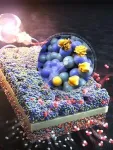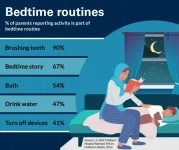(Press-News.org) Things aren’t always as they seem. Take pancreatic cancer, for example. In up to one in 10 cases, researchers have documented a peculiar characteristic. Some of the pancreatic cells appear to have lost their identity. It’s as if they forget what they are.
“This is very bizarre. You see pancreatic cancer, which usually somewhat resembles the original organ, losing those features and basically becoming akin to skin or esophagus—these other very unrelated tissues, " explains former Cold Spring Harbor Laboratory (CSHL) postdoc Diogo Maia-Silva, now at Massachusetts General Hospital.
For years, researchers have wondered exactly how this deadly disease, known as basal-like pancreatic cancer, works. Now, Maia-Silva and colleagues at CSHL have discovered that a protein called MED12 may play a critical role. While the discovery is notable in and of itself, it also builds on decades of CSHL research.
Twenty-five years ago, CSHL Professor Alea Mills discovered that a protein called p63 is important for the formation of normal basal cells—small cells in the lower part of the epidermis. Later research from CSHL Professor Christopher Vakoc found that this protein can also cause pancreatic cancer to become basal-like. Exactly how was unclear. Maia-Silva joined Vakoc’s lab in 2018, wanting to continue this investigation. Because p63 is notoriously difficult to target with drugs, he wondered which other molecules it might work with to confuse cells.
With his colleagues, he developed a method to screen the entire genome of basal-like cancer cells and rank which genes were most important for maintaining their new identity. In all his tests, MED12 rose to the top. This gene contains instructions for making the MED12 protein, one of about 25 in a complex that regulates gene activity.
“That was very unexpected because it’s part of this broad complex, but [most] other members of the complex didn’t show up. Despite being part of this general machinery of the cell, [MED12] has some unique property that makes it more important for basal biology," says Maia-Silva.
Further tests showed that MED12 and p63 bind directly to each other. This suggests that each may be required to turn pancreatic cells basal-like. If researchers could one day figure out how to stop this interaction, it’s possible they could prevent pancreatic cancer from going basal. However, Maia-Silva is quick to note, this isn’t “something that can be easily done.” Still, “this is exciting,” he adds. “Finding these critical partners is sort of a first step toward blocking the pathway.”
It’s a new beginning but also yet another exciting conclusion in a string of discoveries at CSHL.
END
Pancreatic cancer’s cellular amnesia
2024-06-17
ELSE PRESS RELEASES FROM THIS DATE:
An earthquake changed the course of the Ganges. Could it happen again?
2024-06-17
A major earthquake 2,500 years ago caused one of the largest rivers on Earth to abruptly change course, according to a new study. The previously undocumented quake rerouted the main channel of the Ganges River in what is now densely populated Bangladesh, which remains vulnerable to big quakes. The study was just published in the journal Nature Communications.
Scientists have documented many river-course changes, called avulsions, including some in response to earthquakes. However, “I don’t think we have ever seen such a big ...
New study reveals urgent need for region-specific models to improve brain health in diverse settings
2024-06-17
A pioneering study published today in the journal Nature Aging has unveiled significant heterogeneity in the risk factors affecting healthy aging in Latin America and emphasised the limitations of current models of brain health, which are primarily based on data from high-income countries. The research was conducted by researchers from Trinity College Dublin (Ireland), and by colleagues in Universidad Adolfo Ibanez (Chile) and Pontificia Universidad Javeriana (Colombia) among others.
The study developed a metanalytical approach with 146,000 participants and findings emphasise how current models of brain health may not apply ...
Treatment of stress-induced exhaustion disorder has wrong focus
2024-06-17
A new thesis at Uppsala University questions the traditional view of stress-induced exhaustion disorder. A new model is proposed in its place that puts more focus on meaningfulness rather than recovery.
“There are no established evidence-based models for the psychological treatment of stress-induced exhaustion disorder. The concepts of ‘recovery’ and ‘stress’ are so widely accepted in our current era that it is difficult to examine them critically. It’s easy to think that patients with stress-related exhaustion should prioritise rest and relaxation, but an overly one-sided focus on recovery ...
Bedtime battles: 1 in 4 parents say their child can’t go to sleep because they’re worried or anxious
2024-06-17
ANN ARBOR, Mich. – Many bedtime battles stem from children’s after dark worries, suggests a new national poll.
And while most families have bedtime rituals to help their little ones ease into nighttime, many rely on strategies that may increase sleep challenges long term, according to the University of Michigan Health C.S. Mott Children’s Hospital National Poll on Children’s Health.
Overall, one in four parents describe getting their young child to bed as difficult – and these parents are less likely to have a bedtime routine, more likely to leave on a video or TV show, and more likely to stay with their child until they’re ...
Towards wider 5G network coverage: novel wirelessly powered relay transceiver
2024-06-17
A novel 256-element wirelessly powered transceiver array for non-line-of-sight 5G communication, featuring efficient wireless power transmission and high-power conversion efficiency, has been designed by scientists at Tokyo Tech. The innovative design can enhance the 5G network coverage even to places with link blockage, improving flexibility and coverage area, and potentially making high-speed, low-latency communication more accessible.
Millimeter wave 5G communication, which uses extremely high-frequency radio signals (24 to 100 GHz), is a promising technology for next-generation wireless ...
Nile perch invasion triggered genetic bottlenecks in lake Victoria's endemic cichlids
2024-06-17
Newfound evidence reveals that the upsurge of the exotic Nile perch in Lake Victoria had long-lasting effects on the genetic diversity of various local cichlid species, report scientists from Tokyo Tech. Through large-scale comparative genomic analyses, the researchers found concrete proof in the collective genome of multiple species that this artificially introduced perch decimated many local fish populations, causing a 'bottleneck effect.'
The careless introduction of exotic species by humans into ecosystems can lead to truly catastrophic results, as has been ...
Wildfire smoke and health
2024-06-17
With wildfires becoming more frequent and extensive in Canada, it’s important for people to understand the health risks of wildfire smoke. An article in CMAJ (Canadian Medical Association Journal) https://www.cmaj.ca/lookup/doi/10.1503/cmaj.240135 aims to provide information for clinicians and people in Canada as wildfire season is upon us.
"As climate change causes more frequent and severe wildfires, wildfire smoke becomes a larger health problem,” says Dr. Mehdi Aloosh, assistant professor, Health Research Methods, Evidence, and Impact, McMaster University, Hamilton, and medical officer of health of Windsor–Essex County, Ontario. “Communities need ...
US sexual health curriculum could force LGBTQ+ students to seek potentially inaccurate education outside of school
2024-06-17
Children across the United States who identify as LGBTQ+ say the sexual health education curricula they receive is leaving them without essential information to make informed decisions about their sexual health – which could force them to seek potentially dangerous advice elsewhere.
The results of a new, national, peer-reviewed survey, show that these young people — aged 13 to 17 — believe crucial topics surrounding sexual orientation and gender identity are being omitted from sexual health education programs.
Experts who led the study – published today in The Journal of Sex Research, as people around the ...
Increasing use and awareness of oral nicotine pouches detailed
2024-06-17
WASHINGTON – A rigorous, comprehensive synthesis of evidence from 62 studies related to the use of oral nicotine pouches by Georgetown University’s Lombardi Comprehensive Cancer Center scientists and colleagues provides a much-needed assessment of how these products could lead to potential harmful consequences if used by young people.
Oral nicotine pouches were first introduced in the U.S. in the past decade and are pre-portioned white granular packets containing nicotine placed between the gums and lips, marketed as tobacco-free, and are sold in various flavors and nicotine strengths.
The findings appeared ...
Wirelessly powered relay will help bring 5G technology to smart factories
2024-06-17
A recently developed wirelessly powered 5G relay could accelerate the development of smart factories, report scientists from Tokyo Tech. By adopting a lower operating frequency for wireless power transfer, the proposed relay design solves many of the current limitations, including range and efficiency. In turn, this allows for a more versatile and widespread arrangement of sensors and transceivers in industrial settings.
One of the hallmarks of the Information Age is the transformation of industries towards a greater flow of ...








